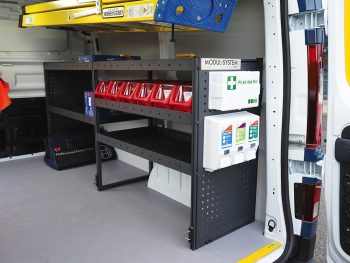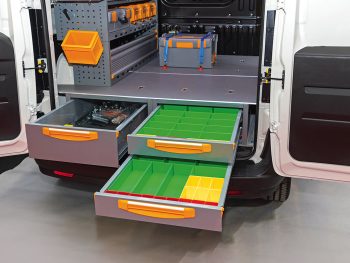Matt MacConnell investigates the challenges around electric van outfitting and how electrical accessories are affected.
 As 2035 approaches, electric van sales have been gradually increasing. According to SMMT data, there were 76,871 electric vans on UK roads at the end of January 2025 – a figure that represents 1.6% of all LCVs on British roads. For perspective, there were 5,266 electric vans in the UK at the end of 2020. Some 13,436 electric vans have been sold since the beginning of 2024, which equates to 4.8% of all new van sales.
As 2035 approaches, electric van sales have been gradually increasing. According to SMMT data, there were 76,871 electric vans on UK roads at the end of January 2025 – a figure that represents 1.6% of all LCVs on British roads. For perspective, there were 5,266 electric vans in the UK at the end of 2020. Some 13,436 electric vans have been sold since the beginning of 2024, which equates to 4.8% of all new van sales.
While these numbers are impressive, the EV switch can be daunting – and questions about vehicles and charging often take precedence. Still, outfitting concerns, such as how EVs affect the work that needs to be done, how electrical accessories are impacted and what outfitting companies are doing to help fleets transition, need to be addressed.
Like cars, electric vans often have their batteries mounted below the floor, which means outfitting companies must think ahead before drilling down and mounting equipment or racking. Manufacturers such as Sortimo have EV-ready products, like the SR5 – and fit a secondary floor so that racking or accessories can be mounted.
Similarly, focus on lightweight materials is important: less weight equals more range and less strain on the vehicle’s motors. Using the van’s door walls to mount cables and plastic shelving can help reduce weight as fewer bins and storage compartments will be required. One of the main purposes of switching to an EV fleet is to reduce environmental impact and, while EVs aren’t completely sustainable due to battery production, fleets can still choose semi-eco-friendly components. Aluminium is often favoured among outfitting companies but it isn’t entirely sustainable as it creates a lot of waste heat. To keep waste heat down, Sortimo uses extreme pressure to bond its SR5 range together rather than welding. The company also offers a handy configurator on its website, which allows fleet managers to customise an electric van’s layout by make and model.
Utility usage
One of the largest challenges for electric vehicles is payload-heavy sectors such as utilities. Vehicles within the utility sector are often larger LCVs, which are used to lug drum carriage trailers wrapped in heavy-duty electric cable or water pipe. They can also be seen pulling mini diggers on trailers, again increasing weight. Therefore, using lighter components is important as wooden, or metal racking could increase payload beyond 3,500kg.
 Van racking and electrical accessory company Modul System believes that another thing fleets should consider during a conversion is how many electrical accessories are needed. Depending on the industry, these can range from floodlights to beacons and require additional power.
Van racking and electrical accessory company Modul System believes that another thing fleets should consider during a conversion is how many electrical accessories are needed. Depending on the industry, these can range from floodlights to beacons and require additional power.
Electric vans have a battery that drives the vehicle and an auxiliary battery that feeds power to the wipers and vehicle lighting. Power for smaller components can be drawn from the vehicle’s auxiliary power, but this can also be done via a conventional converter. If more power is needed, this could mean additional lithium-ion battery packs; the latter adding weight.
Another option is using portable power banks that house an in-built inverter – these can also be used outside the vehicle to power tools such as air compressors and other equipment.
Meanwhile, some companies also offer solar panels that can be mounted to the roof of an LCV. These can be used to charge the van’s battery and feed power into a secondary auxiliary battery bank to charge power tools. Likewise, Modul System stays clear of a van’s Wisadeck floor during outfitting – and uses honeycomb flooring to reduce weight (polypropylene is used instead of plywood, too).
Various manufacturers offer incentives to assist with initial EV costs, but fleet operators and businesses should note that outfitting can be slightly more expensive than a comparable ICE LCV. This includes more expensive lighter flooring to avoid drilling into the existing floor. Similarly, when supporting fleets transitioning to EVs, many outfitting companies will quote depending on the van’s make/model and size. When a quote is accepted, the outfitter will usually install the flooring, racking and accessories at an in-house facility.
As easy as ABC
 Fleet mobility provider Alphabet supported fire detection manufacturer Protec in transforming its commercial vehicle fleet of 160 vans. Before this collaboration, Protec purchased its vans and kitted them out. Now, Alphabet handles design, fitting and fleet branding.
Fleet mobility provider Alphabet supported fire detection manufacturer Protec in transforming its commercial vehicle fleet of 160 vans. Before this collaboration, Protec purchased its vans and kitted them out. Now, Alphabet handles design, fitting and fleet branding.
“We used a crash-test video to illustrate the benefits of using modular metal racking over plywood, along with showcasing the adaptability and sustainability of reusing the new racking to maximise Protec’s return on investment,” explains Simon Simmons, LCV consultant for Alphabet. “We also worked with our partners to ensure that the design and livery of the vehicles were on-brand and ready to go at the point of delivery.”
Herd Synergy also claims to offer a hassle-free outfitting experience and provide bespoke designs that contain items such as metal floors and kickplates, to tail lifts, to extra capacity loading bars. Fleet managers should also consider how far their electric vans will be travelling. A route planner can be an effective way to check the distance between jobs and what chargers are along the way. This is needed if an electric van is kitted out with power tools, racking or works in the utility sector.
While many industries will follow similar layouts, search and rescue teams often require a different setup. System Edström helped convert Essex Search and Rescue’s Peugeot Boxer L4H3 panel van with help from its partners at Richell Vehicle Conversions and Fleetshield. The charity assists the emergency services in locating high-risk, missing individuals who are living with conditions such as dementia.
The team uses two vehicles: an incident control unit for coordinating searches and a support unit to transport team members and equipment. By 2022, the control unit was 22 years old and needed replacing, and it needed to be under 3,500kg, considering the outfitting required. The new vehicle has two separate areas: equipment storage and a control area. The equipment storage holds medical bags, radios, torches and stretchers. Meanwhile, the control area is the centre of operations and has two networked computers, screens, printers, routers, heating and integrated power systems.
“Essex Search and Rescue had a clear vision of their new vehicle’s needed capabilities,” says Chris Angel, System Edström UK sales manager. “By collaborating closely with them and Richell Vehicle Conversions, we helped design a vehicle that efficiently used the van’s space while accommodating the necessary specialist equipment.”

